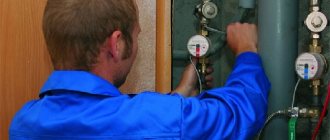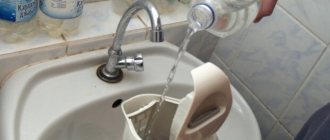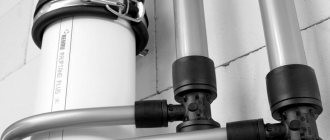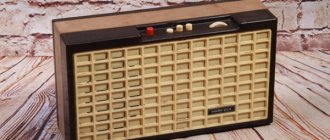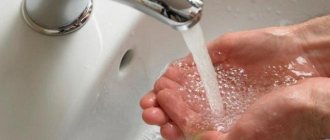Standard for multi-storey buildings
This parameter is recorded in a special SNIP. Also, the specified building rules establish the standard pressure in pipes.
The standard recorded in SNIP
Requirements regarding water pressure in houses are specified in SNIP 2.04.02-84.
These rules state that the pressure in the water supply must be at least 10 m .
If the house has several floors, then with each subsequent floor the norm should increase by 4 m. The required pressure indicator in a house with one floor is 1 atmosphere.
This SNIP also stated that the pressure in the water supply system should not exceed 60 m . This corresponds to an indicator of 6 atmospheres. Pressure in the range from 1 to 6 atmospheres is considered sufficient.
For hot and cold
In clause 5.12 of another SNIP numbered 2.04.01-85 it is stated that pressure in pipes with hot water will be considered normal if it does not exceed 4.5 atm.
For pressure in a cold water pipeline, general requirements are provided for, as stated in the previously mentioned building rules. An indicator of up to 5.5 atmospheres will be considered normal .
Minimum and maximum indicators
The same minimum is established for hot and cold water pipes. It is equal to 0.3 atm.
A minimum pressure of 0.3 atm is fixed for shower stalls, as well as bathtubs equipped with mixers. In washbasins equipped with faucets and toilets with flush tanks, the minimum value should be 0.2 atmospheres.
The maximum permitted hot water pressure is fixed by SNIP 2.04.01-85. It is equal to 4.5 atmospheres. The maximum pressure in cold water pipelines should be 6 atmospheres.
What pressure is enough for full consumption?
Most apartment building residents use water in a very predictable manner. They shower periodically, wash dishes daily, wash their face, and turn on the washing machine several times a week. To ensure these manipulations, it is enough to have a pressure (pressure) of 2 atm in the water supply. If a massage shower or jacuzzi is installed in the bathroom, they will only work at a pressure of at least 4 atm.
Excessively high pressure in the network leads to rapid wear or irreversible destruction of ceramic faucets and sanitary equipment.
Some features of autonomous water supply systems
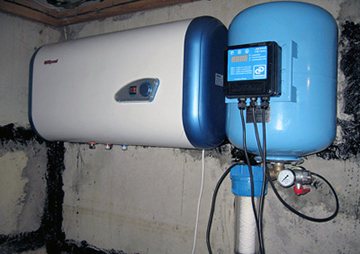
The source of autonomous water supply is a well or borehole.
In both cases, water is supplied to the pipeline through pumps. It is this unit that creates the pressure in the pipes necessary to deliver water to consumers - taps, washing machines or dishwashers, etc.
However, not only its power and performance affect the level of free pressure in the water supply. Well flow plays a big role in this issue.
If there is not enough water in the source, the pump will not be able to provide the required pressure in the network immediately after it is turned on. If there is an excess amount of water in the well, there is a risk of a significant increase in pressure, which can lead to various types of accidents - leaks, broken faucets, etc.
In the first case, the homeowner has to take measures to increase the water pressure in the water supply; in the second, he must correctly select the pump capacity so that it plays the role of a kind of limiter.
How to determine it yourself?
The pressure in the pipeline can be measured independently with a pressure gauge . The device must be connected to any indoor water source. A pressure gauge can be attached to a shower head, measure the indicator and compare it with the standard.
At home, you can find out the approximate pressure by conducting a simple experiment. You need to take a 3-liter jar, turn on the stopwatch and start filling the container with tap water. The tap itself must be turned on all the way.
After filling the jar with water, you must turn off the stopwatch. Usually, at normal pressure, the container is completely filled in 8-10 seconds.
What are they regulated by?
The basis for regulating the norm of water supply supplied to residential premises is SNiP 2.04.2-84, according to which central water supply systems are designed.
According to this SNiP, the minimum input water pressure on the ground floor is 1 bar (1 atmospheric unit), which allows creating a water column of 10 meters.
In an apartment building
In an apartment building, for each additional floor, the inlet water pressure must be increased by 4 meters, or 0.4 bar.
For example, in a 5-story building, the formula for calculating the pressure of the supplied water looks like this:
10+(4*5)=30 meters, or 3 atmospheres,
where 10 (m) is the minimum water pressure supplied to the 1st floor, 4 (m) is the conventionally accepted floor height, 5 is the number of floors.
This is the minimum value of the water supply pressure to the first floor of a 5-story building, approved by building codes.
In a private house
Water pressure in a private residential building is calculated based on its number of floors. Since the height of private houses rarely exceeds 10 meters, for most private buildings the established minimum standards are considered to be 1 atmospheric unit .
If the 10-meter mark is exceeded, the minimum value is set at 2 atmospheres.
How to understand who is to blame for poor pressure?

The following reasons for insufficient pressure in the water supply system are possible:
- clogs inside faucets, as well as in water filters;
- failure of mixers;
- fouling of pipes from the inside with plaque;
- breakdown of the filter element inside the geyser, if it is used in an apartment.
In these cases, the tenant himself is responsible for poor pressure in the pipeline, since the decrease in pressure was caused by a breakdown or clogging of devices that are located within his own apartment.
This property will be considered personal. The resident will have to clean the filters and faucets themselves or replace them completely.
He will also have to replace individual pipeline sections in the apartment with his own resources and resources if they are severely damaged by lime. Also, if the filter element in a gas water heater breaks down, the resident will have to repair the device using his own means.
It is recommended to first check all faucets with filters in your home . If necessary, you can gently tap the pipes with a hammer to get rid of excess lime inside them. Also, if you have a geyser, it is recommended to check the filter element inside it.
If the cause is not faucets with filters, as well as the pipeline inside the apartment, then it is necessary to check the connections of the pipes in the entire water supply system.
It is recommended to check the condition of the riser and all equipment installed in the basement of the house. To do this, you will need to contact the Criminal Code. The pumping station may also need to be checked.
Compilation procedure and sample
The form of the act of work performed was approved by Order of the Ministry of Construction No. 761 in October 2015. This document must contain the following information:

- name of the management company or homeowners association, details and legal address;
- name and details of the contractor;
- address of the house and number of the entrance where the work was carried out;
- Full name of the contractor’s representative and his passport details;
- list of completed works;
- deadlines;
- unit of measurement of the cost of work;
- the volume of work performed of each type and the total cost;
- information about the presence of claims from the customer of the work (CC);
- date of compilation and signature of representatives of the management company and the contractor company.
In the column “Deadlines for completion” the deadlines for the delivery of work under the terms of the contract and the actual deadlines are indicated. If the delivery of work is carried out later than the period specified in the contract, then the act may indicate the accrual of late fees and its amount. For regularly performed work (cleaning entrances, watering the lawn, etc.), it is not the deadlines for completion that are indicated, but the frequency of completion or the number of the calendar month.
Where to contact if you do not meet the requirements?

You need to file a complaint. This document requires you to write that the company provides services of poor quality.
It is also necessary to require the management company to check the condition of the water supply system in the house and at the pumping station, as well as recalculate the completed and sent utility bills.
The management company must respond to the complaint within 30 days . If the company does not take proper measures, then you should contact the housing inspector. You can also complain about the inaction of the Criminal Code to the city administration and the prosecutor's office. If these structures do not take proper actions, then a lawsuit should be filed.
What is an act and when is it necessary?
In housing legislation, an act is understood as a document that records the state of the common or private property of residents at a specific point in time, and also confirms the absence of claims when the owner of the property changes or the work is accepted.
House management organizations (MCs or HOAs) fill out the following types of acts:
- act of acceptance and transfer;
- Act of executed works;
- inspection or survey report.
This document contains a detailed description of the property being transferred and the signatures of the transferring and receiving parties.
An equipment inspection report (for example, plumbing or heating systems in residents’ apartments) is necessary for the purposes of:
- plumbing damage assessments;
- determining the possibility of installing metering devices;
- determining the cost of repairs.
An act of completion of work is drawn up as confirmation that the management company has completed all necessary repairs and maintenance of common property. This document also allows premises owners to control the quality of work performed and the amount of money spent, and it will be easier for employees of the management company or HOA to generate reports to the audit commission or housing inspection.
Can I try to increase it on my own?
If the management company refuses to resolve the problem and there is no response from other organizations, you can independently deal with this issue.
If the cause of insufficient pressure is the appliances inside the apartment, then the resident will in any case have to solve this problem himself by cleaning or replacing filters, mixers, and pipes.
If the cause is problems with house devices and pipes, then residents have the right to solve this problem themselves by installing pumps inside their homes .
This is allowed only if the residents of the house and the management company have been notified about this event, and the installation of the pump does not affect the water supply to other apartments.
How to find out pressure
Accurate information about the pressure in the pipeline is required when developing a system for its normalization. To do this, install a water pressure gauge to measure the water pressure in the water supply and take readings from it within a week.
This is done at least 4 times a day: at night and in the morning, during the day and in the evening. Based on the results obtained, maximum and minimum values are determined and compared with regulatory requirements. Based on the result obtained, the optimal method of increasing pressure is selected.
You have probably encountered such a problem as noise in water pipes. Many people try not to pay attention to this, but in fact this problem needs to be solved. Why water pipes hum and how to diagnose and fix the problem, read on.
We will discuss ways to replace the gasket in a faucet in this topic.
Instructions for enlargement
The problem can be solved by installing an indoor pump . At the same time, only special devices designed strictly for one apartment are suitable for installation.
You should not try to install pumping equipment designed for private homes in apartments.
The pump must be installed according to the following diagram:
- Notify the management company and the residents of the house in writing about the intention to install a pump in the apartment.
- After receiving consent, purchase the device.
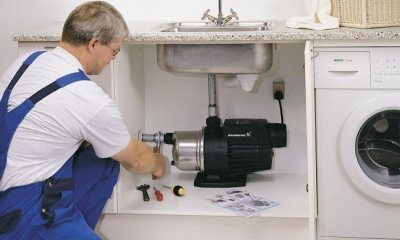
Before installing the device, clean all pipes from lime, check the condition of the mixers and filter elements. If necessary, clean them or replace them completely.- Turn off the water.
- Cut a section on the pipeline for the pump.
- Install ball valves on both sides of the pipes.
- Connect the pump to the system using leads.
- Check the tightness of the mechanism.
- Perform electrical installation of the pump pump.
Installation of the pump in the apartment is carried out with special tools. Installation of the device can only be carried out by a specialist or person with sufficient knowledge.
Pump for water pressure in water supply
The most popular brands of pumps among apartment owners are:
- Comfort: efficient and economical devices. Pumps of this brand are classified as universal - they can be installed on hot and cold water. The product body is made of stainless steel. There are seven modifications, differing from each other in the design pressure (from 8 to 10 m) and throughput (nominal - from 8 to 12 l/min, maximum - from 20 to 30 l/min);
- WILO: domestic pumps of European class, excellent quality, universal. Vilo pumps are equipped with a flow sensor, the motor cooling system is “wet rotor”. They are designed for maximum pressure from 9 to 20 m and flow capacity from 2.4 to 35 l/min (depending on the model);
The UNIPUMP pump also received good reviews. It has a small installation length, which makes it easy to install.
